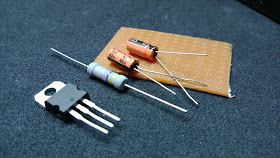Introduction:
Most of the mobile phones these days can be charged from a USB port with an output of 5 v DC. There are a variety of devices that run by taking power from a USB port. My idea was to construct a 5 v constant voltage circuit using readily available components, keep it as simple as possible and with the least number of components [ 4 components ] . Here is the result, feel free to try it out and pass it on to any one who you think would find it useful.Applications:
- USB mobile charger construction.
- Mobile car charger from the cigarette lighter plug.
- 5v source for electronic projects and IC's.
- Solar powered mobile phone chargers.
- Solar powered battery charger.
- Constant power output from a variable source like a dynamo/generator.
and many many more.... :)
Construction:
Here is a picture of the positive and negative terminal connection of the USB.The components we will use are:
- One - LM7805
- Two - 1μf Capacitor
- One - 5 Ω 3 Watt Resistor
LM7805:
The LM 7805 is a three pin voltage regulator.It takes in a voltage of 7 to 30 volts and regulates it down to 4.8 ~ 5.2 volts: it can provide up to 1.5 Amps of current. The first pin is the input [+] pin, the second [ middle ] pin is the negative pin and the third the output pin. The first capacitor takes out any ripple coming from the source so that the 7805 is receiving a smooth input voltage, and the second capacitor acts as a load balancer to ensure consistent output from the 7805. A resistor is added in series to the output to reduce the output current and this also helps prevent the over heating of the 7805. The circuit is very simple and can be soldered very quickly on a small general purpose PCB. The components from left to right are, 7805 , 5.4 ohm resistor and two 1uf capacitors. It would be ideal to use a heat sink on the 7805 to prevent it from overheating.
The circuit is very simple and can be soldered very quickly on a small general purpose PCB. The components from left to right are, 7805 , 5.4 ohm resistor and two 1uf capacitors. It would be ideal to use a heat sink on the 7805 to prevent it from overheating.I have sketched the layout along with the 7805's pin configuration. It is a fairly simple and straight forward circuit. The positive input is connected to both the pin one of the 7805 and the positive of the first capacitor . The pin three is connected to the positive of the capacitor and one end of the resistor, this forms the positive 5 v output. This completes our positive side. For the negative we connect all the negatives together - the negative in, negative out, negative of the first capacitor, negative of the second capacitor and pin 2 of the 7805.
 The output can be taken as a wired output or a USB port can be directly mounted on to the PCB. Here you see the completed board. I have drilled two holes to secure the port later. The red and the black wires are the input wires.
The output can be taken as a wired output or a USB port can be directly mounted on to the PCB. Here you see the completed board. I have drilled two holes to secure the port later. The red and the black wires are the input wires.p.s: By varying the resistance of the resistor between 5 and 15 ohms the output current can be reduced or increased as per requirement. While doing this ensure that the resistor you use is rated at 3 watts or above and that the 7805 has a very good heat sink and that it doesn't overheat. A small amount of heat however is quite normal.
Below is a video of the circuit in action:



Awesome Work Thank you........
ReplyDeleteYou are welcome
Deleteit works ...but it discharge my cell phone battery... what to do should i use diode to block reverse current..
ReplyDeleteIn that case it would be good to use a diode. There would be a 0.7 Volt drop when a diode is used.
DeleteCould you please tell me how to connect USB port onto this PCB board
ReplyDeleteCould you please tell me how to connect USB port onto this PCB board
ReplyDeleteConnect the pin 1 of the USB to positive and pin 4 to the negative of the 5V output from the circuit.
DeleteHi Joseph, I teally like the semplicity of you project. I was trying to build something similar, input 5v, output usb port like yours and 2500mah lipo with protection board. If I connect just the usb port to the circiit is working supplying my phone with charge but if I add the lipo, it will lowering the entire circuit to 3.6v (its initual charge voltage I suppose) making the usb unable to charge phone anymore. Should I need to add a resistor or something else to keep the circuit within 5v? The lipo should be protected anyway by its board. Thanks in advance for your help. Andrea
ReplyDeleteMost of the time I don’t make comments on websites, but I'd like to say that this article really forced me to do so. Really nice post. herbalcoast variable battery usb charger
ReplyDeleteBuy best apple charger and plug and get the best deals at the lowest prices on shopify! Great Savings & Free Delivery / Collection on many items.
ReplyDelete